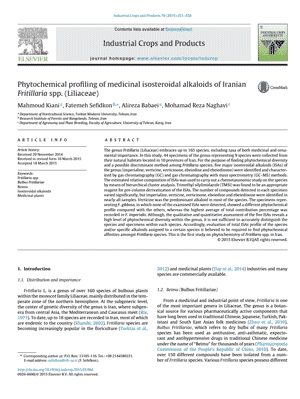NEWS 2015
Phytochemical profiling of medicinal isosteroidal alkaloids of Iranian Fritillaria spp. (Liliaceae)
Mahmoud KIANI¹, Fatemeh SEFIDKON², Alireza BABAEI¹, Mohamad REZA NAGHAVI³
Industrial Crops and Products 70: 451–458 (2015)
doi:10.1016/j.indcrop.2015.03.064
¹Department of Horticultural Science, Tarbiat Modares University, Tehran, Iran
²Research Institute of Forests and Rangelands, Tehran, Iran
³Department of Agronomy and Plant Breeding, Faculty of Agriculture, University of Tehran, Karaj, Iran
Abstract
The genus Fritillaria (Liliaceae) embraces up to 165 species, including taxa of both medicinal and or ornamental importance. In this study, 44 specimens of the genus representing 9 species were collected from their natural habitats located in 10 provinces of Iran. For the purpose of finding phytochemical diversity and a possible discriminant method among Fritillaria species, five major isosteroidal alkaloids (ISAs) of the genus (imperialine, verticine, verticinone, ebeiedine and ebeiedinone) were identified and characterized by gas chromatography (GC) and gas chromatography with mass spectrometry (GC–MS) methods. The estimated relative composition of ISAs was used to carry out a chemotaxonomic study on the species by means of hierarchical cluster analysis. Trimethyl silylimidazole (TMSI) was found to be an appropriate reagent for pre-column derivatization of the ISAs. The number of compounds detected in each specimen varied significantly, but imperialine, verticine, verticinone, ebeiedine and ebeiedinone were identified in nearly all samples. Verticine was the predominant alkaloid in most of the species. The specimens representing F. gibbosa, in which none of the examined ISAs were detected, showed a different phytochemical profile compared with the others, whereas the highest average of total contribution percentage was recorded in F. imperialis. Although, the qualitative and quantitative assessment of the five ISAs reveals a high level of phytochemical diversity within the genus, it is not sufficient to accurately distinguish the species and specimens within each species. Accordingly, evaluation of total ISAs profile of the species and/or specific alkaloids assigned to a certain species is believed to be required to find phytochemical affinities amongst Fritillaria species. This is the first study on phytochemistry of Fritillaria spp. in Iran.

